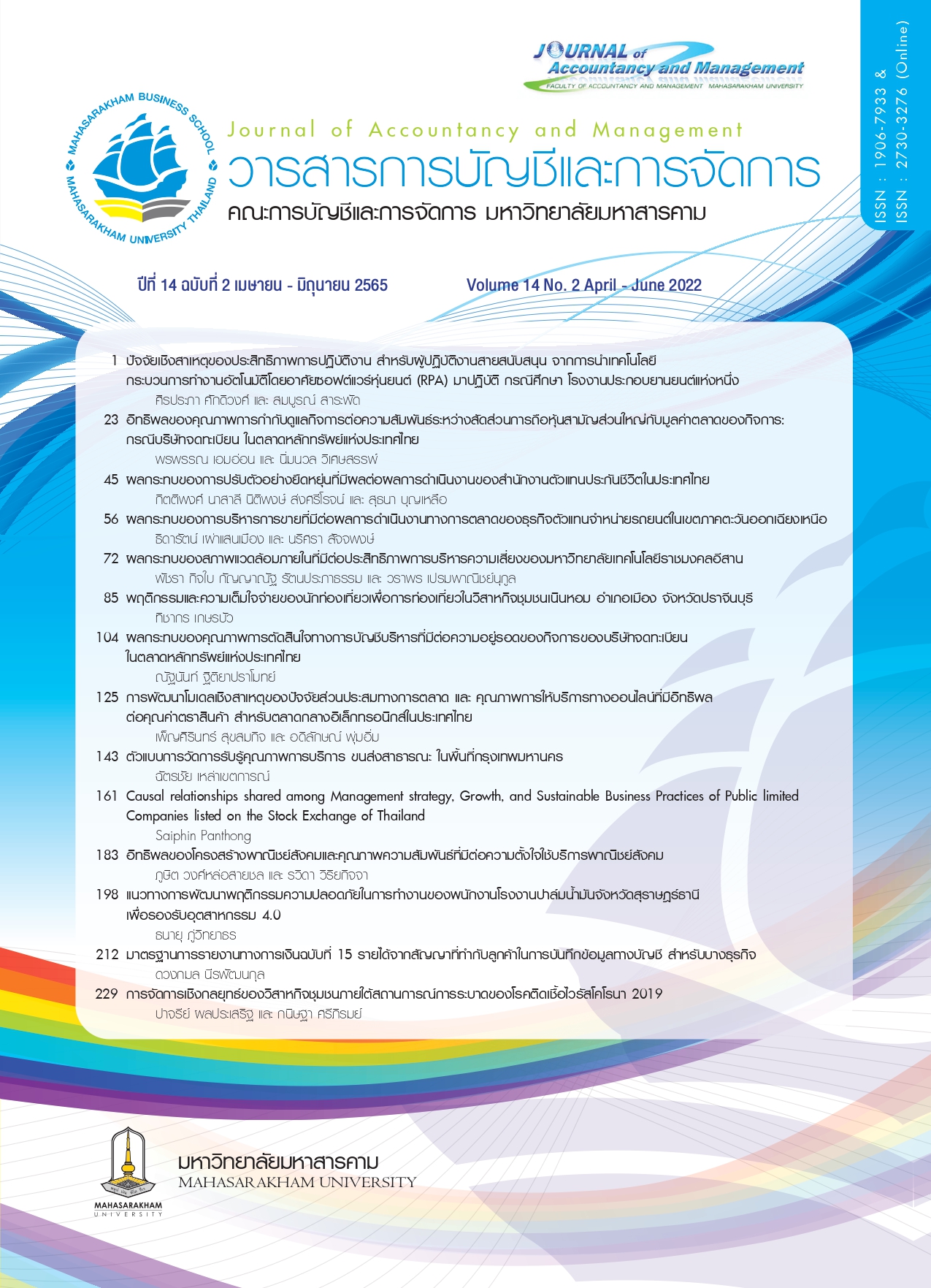ปัจจัยเชิงสาเหตุของประสิทธิภาพการปฏิบัติงาน สำหรับผู้ปฏิบัติงานสายสนับสนุน จากการนำเทคโนโลยี กระบวนการทำงานอัตโนมัติโดยอาศัยซอฟต์แวร์หุ่นยนต์ (RPA) มาปฏิบัติ กรณีศึกษา โรงงานประกอบยานยนต์แห่งหนึ่ง
Main Article Content
บทคัดย่อ
งานวิจัยนี้มีวัตถุประสงค์เพื่อศึกษาถึงปัจจัยเชิงสาเหตุของประสิทธิภาพการปฏิบัติงาน จากการนำเทคโนโลยี กระบวนการทำงานอัตโนมัติโดยอาศัยซอฟต์แวร์หุ่นยนต์ (RPA) มาปฏิบัติ โดยทำการศึกษาจากผู้ปฏิบัติงานสายสนับสนุนของโรงงานประกอบยานยนต์แห่งหนึ่งจำนวน 179 คน ที่มีประสบการณ์ในการใช้งาน RPA โดยใช้แบบสอบถามเป็นเครื่องมือในการวิจัย นำผลมาวิเคราะห์ด้วยค่าสถิติเชิงพรรณนาและทดสอบสมมติฐานด้วยการวิเคราะห์เส้นทาง (Path analysis) ผลการทดสอบความกลมกลืนของโมเดลในภาพรวมพบว่าโมเดลทฤษฎีมีความสอดคล้องกับข้อมูลเชิงประจักษ์ ดังนี้ Chi-square = 10.183, p-value = 0.252, CMIN/DF = 1.273, GFI = 0.984, AGFI = 0.945,
CFI = 0.996, RMSEA = 0.039, RMR = 0.009 ผลการวิจัย พบว่า ปัจจัยที่ส่งผลต่อความตั้งใจใช้งานเทคโนโลยี RPA นั้นขึ้นอยู่กับความคาดหวังด้านประสิทธิภาพและอิทธิพลทางสังคม ในขณะที่ความคาดหวังด้านความพยามและสิ่งอำนวยความสะดวกไม่มีอิทธิพลเชิงบวกต่อความตั้งใจที่จะใช้ แต่สิ่งอำนวยและความตั้งใจที่จะใช้มีอิทธิพลเชิงบวกต่อพฤติกรรมการใช้ สุดท้ายพฤติกรรมการใช้ก็มีอิทธิพลเชิงบวกต่อประสิทธิภาพการปฏิบัติงาน
Downloads
Article Details

อนุญาตภายใต้เงื่อนไข Creative Commons Attribution-NonCommercial-NoDerivatives 4.0 International License.
บทความที่ได้รับการตีพิมพ์เป็นลิขสิทธิ์ของวารสารการบัญชีและการจัดการ
ข้อความที่ปรากฏในบทความแต่ละเรื่องในวารสารวิชาการเล่มนี้เป็นความคิดเห็นส่วนตัวของผู้เขียนแต่ละท่านไม่เกี่ยวข้องกับมหาวิทยาลัยมหาสารคาม และคณาจารย์ท่านอื่นๆในมหาวิทยาลัยฯ แต่อย่างใด ความรับผิดชอบองค์ประกอบทั้งหมดของบทความแต่ละเรื่องเป็นของผู้เขียนแต่ละท่าน หากมีความผิดพลาดใดๆ ผู้เขียนแต่ละท่านจะรับผิดชอบบทความของตนเองแต่ผู้เดียว
เอกสารอ้างอิง
จิรายุส ปิ่นสินชัย. (2561). การศึกษาปัจจัยที่มีอิทธิพลต่อการยอมรับและใช้เทคโนโลยีระบบตรวจสอบกระเป๋าสัมภาระก่อนขึ้นเครื่อง (PBRS) ท่าอากาศยานนานาชาติสุวรรณภูมิ. วิทยานิพนธ์ปริญญามหาบัณฑิต มหาวิทยาลัยรังสิต.
ชาญชัย อรรคผาติ. (2557). ปัจจัยที่ส่งผลต่อทัศนคติในการยอมรับเทคโนโลยีคลาวด์คอมพิวติ้ง เพื่อประยุกต์ใช้ในการให้บริการระบบบัญชีออนไลน์ สำหรับวิสาหกิจขนาดกลางและขนาดย่อม ในมุมมองของผู้ทำบัญชี. วิทยานิพนธ์ปริญญามหาบัณฑิต มหาวิทยาลัยธุรกิจบัณฑิตย์.
ชูศรี วงศ์รัตนะ. (2560). เทคนิคการใช้สถิติเพื่อการวิจัย. กรุงเทพฯ : อมรการพิมพ์.
ณัฐพร ไชยยากูลวัฒน์. (2560). การประยุกต์ทฤษฎีรวมการยอมรับและใช้เทคโนโลยีเพื่อเข้าใจการยอมรับชุมชนการลงทุน เสมือนของนักลงทุนรายย่อย. การค้นคว้าอิสระปริญญามหาบัณฑิต มหาวิทยาลัยกรุงเทพ.
ธาดาธิเบศร์ ภูทอง และนัทธมน มั่งสูงเนิน. (2560). ปัจจัยที่มีอิทธิพลต่อความตั้งใจในการยอมรับบริการสุขภาพผ่านโทรศัพท์เคลื่อนที่ของผู้สูงอายุ. Veridian E-Journal, Silpakorn University (Humanities, Social Sciences and arts), 10(3), 548-566.
นิภาพร มนชม. (2559). ปัจจัยที่มีผลต่อประสิทธิภาพในการปฏิบัติงานด้านบัญชีด้วยระบบบริหารการเงินกคลังภาครัฐแบบอิเล็กทรอนิกส์ (GFMIS) ของหน่วยงานที่เบิกจ่ายเงินกับสำนักงานคลังจังหวัดระนอง. การประชุมวิชาการและนำเสนอผลงานวิจัยระดับชาติและนานาชาติ ครั้งที่ 7, 1310-1322.
บวรรัฐ มาเจริญ และประพันธ์ ชัยกิจอุราใจ. (2563). ความคิดเห็นของบุคลากรหน่วยงานในกระบวนการยุติธรรมเกี่ยวกับภาวะผู้นำการเปลี่ยนแปลงและบรรยากาศองค์การที่มีอิทธิพลต่อประสิทธิภาพในการปฏิบัติงาน. วารสารวิทยบริการ มหาวิทยาลัยสงขลานครินทร์, 31(1), 90-100.
บัณฑิตา สุขสวัสดิ์. (2558). อิทธิพลของการยอมรับเทคโนโลยีที่มีต่อความตั้งใจในการเลือกใช้โปรแกรมระบบบริหารจัดการเครื่องคอมพิวเตอร์ในระบบเครือข่าย. วิทยานิพนธ์ปริญญามหาบัณฑิต มหาวิทยาลัยเกษตรศาสตร์.
ปฐวี ฉลวย สิงหะ ฉวีสุข, และณฐพล พันธุวงศ์. (2560). การประยุกต์ใช้ทฤษฎีรวมการยอมรับการใช้ เทคโนโลยี (UTAUT) และ ส่วนขยายทฤษฎีรวมการยอมรับการใช้เทคโนโลยี (UTAUT2) กับการทำ ธุรกรรมทางอิเล็กทรอนิกส์. วารสารเทคโนโลยีสารสนเทศลาดกระบัง, 4(2), 1-15.
พิมพ์พรรณ สุวรรณศิริศิลป์. (2559). ปัจจัยที่ส่งผลต่อการยอมรับและใช้งานบริการแบบพร้อมเพย์. การค้นคว้าอิสระปริญญามหาบัณฑิต มหาวิทยาลัยธรรมศาสตร์.
มัญชรัตน์ นันเพ็ญ. (2550). การศึกษาผลกระทบของคุณภาพชีวิตต่อผลประกอบการขององค์กร กรณีศึกษา 10 องค์กรชั้นนำในปี 2549. สารนิพนธ์. กรุงเทพฯ : สถาบันบัณฑิตพัฒนบริหารศาสตร์
รัชดาพร สุธาโภชน์ และคณะ. (2560). อิทธิพลของคุณภาพระบบต่อการใช้งาน ความพึงพอใจของผู้ใช้งาน และประโยชน์สุทธิของผู้ใช้งานระบบ Navis ภายในท่าเรือแหลมฉบัง. Suranaree Journal of Social Science, 11(2), 145-162.
วันทนีย์ มงคลทรัพย์กุล และคณะ. (2559). ปัจจัยที่มีผลต่อการยอมรับบริการอิเล็กทรอนิกส์ภาครัฐ กรณีศึกษาการยื่นแบบและชำระภาษีออนไลน์. วารสารวิจัยและพัฒนา มจธ. 39(1), 3-9.
สิงหะ ฉวีสุข และสุนันทา วงศ์จตุรภัทร. (2555). ทฤษฎีการยอมรับการใช้เทคโนโลยีสารสนเทศ. KMITL Information Technology Journal (Jan. – Jun. 2012).
สุชาติ ประสิทธิ์รัฐสินธุ์. (2546). ระเบียบวิธีการวิจัยทางสังคมศาสตร์. กรุงเทพฯ : สำนักพิมพ์ เฟื่องฟ้าพริ้นติ้ง จำกัด.
อภิญญา ดวงภักดี. (2560). ปัจจัยที่มีอิทธิพลต่อประสิทธิภาพการใช้ระบบสารสนเทศทางการบัญชีเพื่อการวางแผนทรัพยากร : กรณีศึกษาบริษัทผลิตไม้ยางพาราแปรรูปในประเทศไทย. วิทยานิพนธ์ปริญญามหาบัณฑิต มหาวิทยาลัยสงขลานครินทร์.
อรรตพล วงศ์สุขศรี. (2557). ปัจจัยที่มีอิทธิพลต่อประสิทธิภาพการดำเนินงานด้วยระบบอีอาร์พีในธุรกิจก่อสร้าง. การค้นคว้าอิสระปริญญามหาบัณฑิต มหาวิทยาลัยเทคโนโลยีราชมงคลธัญบุรี.
อรวรรณ สุขยานี. (2558). ความตั้งใจในการใช้ระบบสารสนเทศการบริหารทรัพยากรบุคคลของบุคลากร
สถาบันบัณฑิตพัฒนบริหารศาสตร์ : การประยุกต์ใช้ตัวแบบการยอมรับเทคโนโลยี. รายงานผลการวิจัยสถาบันบัณฑิตพัฒนบริหารศาสตร์
อลงกรณ์ ศุภธำรง. (2557). อิทธิพลของคุณภาพระบบต่อการใช้งาน ความพึงพอใจและประโยชน์สุทธิของผู้ใช้งานโปรแกรมสตีม. การค้นคว้าอิสระปริญญามหาบัณฑิต มหาวิทยาลัยกรุงเทพ.
อัมพล ชูสนุก ภัทรลักษณ์ บุญมานำสิน และ ฉวีวรรณ ชูสนุก. (2559). อิทธิพลของคุณภาพระบบต่อการใช้งานความพึงพอใจและประโยชน์สุทธิที่ได้รับของผู้ใช้งานระบบงานให้บริการด้านเรือสินค้าคลังสินค้าเครื่องมือทุ่นแรงและใบแจ้งหนี้ค่าภาระต่าง ๆ ของการท่าเรือแห่ง ประเทศไทย. Suranaree Journal of Social Science, 10(2), 119-135.
อาทิตย์ เกียรติกำจร และภูมิพร ธรรมสถิตเดช. (2557). ปัจจัยที่มีอิทธิพลต่อการยอมรับเทคโนโลยี: กรณีศึกษาการใช้เทคโนโลยี Interactive Whiteboard ในการเรียนการสอนของคณะแพทยศาสตร์ศิริราชพยาบาล. การประชุมวิชาการเสนอผลงานวิจัยระดับบัณฑิตศึกษา ครั้งที่ 15, 545-555.
อุษณา ภัทรมนตรี และ วรพรรณ เรืองผกา. (2552). เทคนิคการทดสอบความสามารถการใช้งานในการตรวจสอบภายใน : กรณีศึกษาโปรแกรมระบบบริหารโครงการ. วารสารเกษตรศาสตร์ธุรกิจประยุกต์, 3(1), 11-22.
Alshehri, A., Rutter, M. J., & Smith, S. (2019). An Implementation of the UTAUT Model for Understanding Students' Perceptions of Learning Management Systems: A Study Within Tertiary Institutions in Saudi Arabia. International Journal of Distance Education Technologies (IJDET), 17(3), 1-24. doi:10.4018/IJDET.2019070101
Andreas M. R., Minh, T. D., & Tan, A. (2020). Using Robotic Process Automation (RPA) to Enhance item Master Data Maintenance Process. Scientific Journal of Logistics, 16(1), 129-140.
Arhinful, L. (2016). Learning Management System adoption in the university: Exploring the experiences of Canadian and international students. Master of Arts, Faculty of Social Sciences, Brock University
Cabrera-Sanchez, J.-P., & Villarejo-Ramos, Á. F. (2019). Factors Affecting the adopting the Adoption of Big Data Analytics in Companies. Revista de Administração de Empresas, 59(6), 415–429. doi:10.1590/s0034-759020190607
Devarajan, Y. (2018). A Study of Robotic Process Automation Use Cases Today for Tomorrow's Business. International Journal of Computer Techniques, 5(6), 12-18.
Diamantopoulos, A. & Siguaw, J. A., (2000). Introduction to LISREL : A guide for the uninitiated. London : SAGE Publications, Inc,.
Fernandez, D., & Aman, A. (2018). Impacts of Robotic Process Automation on Global Accounting Services. Asian Journal of Accounting and Governance, 9, 123–132. doi:10.17576/ajag-2018-09-11
Garima, R., Hemraj, V., & Sushil, R. (2018). Determining factors influencing cloud services adoption in India. Serbian Journal of Management, 13(2), 335–352. doi:10.5937/sjm13-13207
Hair, J. F., Black, W. C., Babin, B. J., & Anderson, R. E., (2010). Multivariate data analysis: A global perspectives. Upper Saddle River, NJ : Pearson Education International.
Holmberg, D., & Härning-Nilsson, M. (2020). Managing Robotics Process Automation (RPA)-A Qualitative Case Study of the Adoption and Implementation Process in the Banking Sector. Master’s Programme in International Strategic Management, School of Economics and Management Lund University.
Jöreskog, K. G., & Sörbom, D. (1993). LISREL 8: Structural equation modeling with the SIMPLIS command language. Scientific Software International; Lawrence Erlbaum Associates, Inc.
Juntunen, K. (2018). Influence of contextual factors on the adoption process of Robotic process automation (RPA): Case study at Stora Enso Finance Delivery. Master Programme in Industrial Management and Innovation, Uppsala University.
Kline, R. B. (2005). Principles and practice of structural equation modeling. 2nd ed. New York : Guilford.
Liu, L., Cruz, A., & Juzwishin, D. (2018). Caregivers as a proxy for responses of dementia clients in a GPS technology acceptance study. Behaviour & Information Technology, 37(6), 634–645. doi:10.1080/0144929x.2018.1470672
Madakam, S., Holmukhe, R. M., & Kumar Jaiswal, D. (2019). The Future Digital Work Force: Robotic Process Automation (RPA). Journal of Information Systems and Technology Management, 16, 1–17. doi:10.4301/s1807-1775201916001
Mahande, R. D., & Malago, J. D. (2019). An E-Learning Acceptance Evaluation through UTAUT Model in a Postgraduate Program. Journal of Educators Online, 16(2), n2.
Techsauce Team. (2563). SCG นำเทคโนโลยี 5G ยกระดับภาคการผลิตสู่ Smart Factory ตอบรับอุตสาหกรรม 4.0. ค้นเมื่อ 17 มีนาคม 2563. จาก https://techsauce.co/pr-news/scg-ais-digital-transformation-smart-disruption,
Vanhanen, J. (2020). Automation of financial management processes by utilizing robotic process automation: a Finnish banking case. Degree Programme in Business Administration, School of Business and Management LAPPEENRANTA-LAHTI UNIVERSITY OF TECHNOLOGY LUT.
Venkatesh, V., Morris, M. G., Davis, G. B., & Davis, F. D. (2003). User acceptance of information technology: Toward a unified view. MIS quarterly, 425-478.


